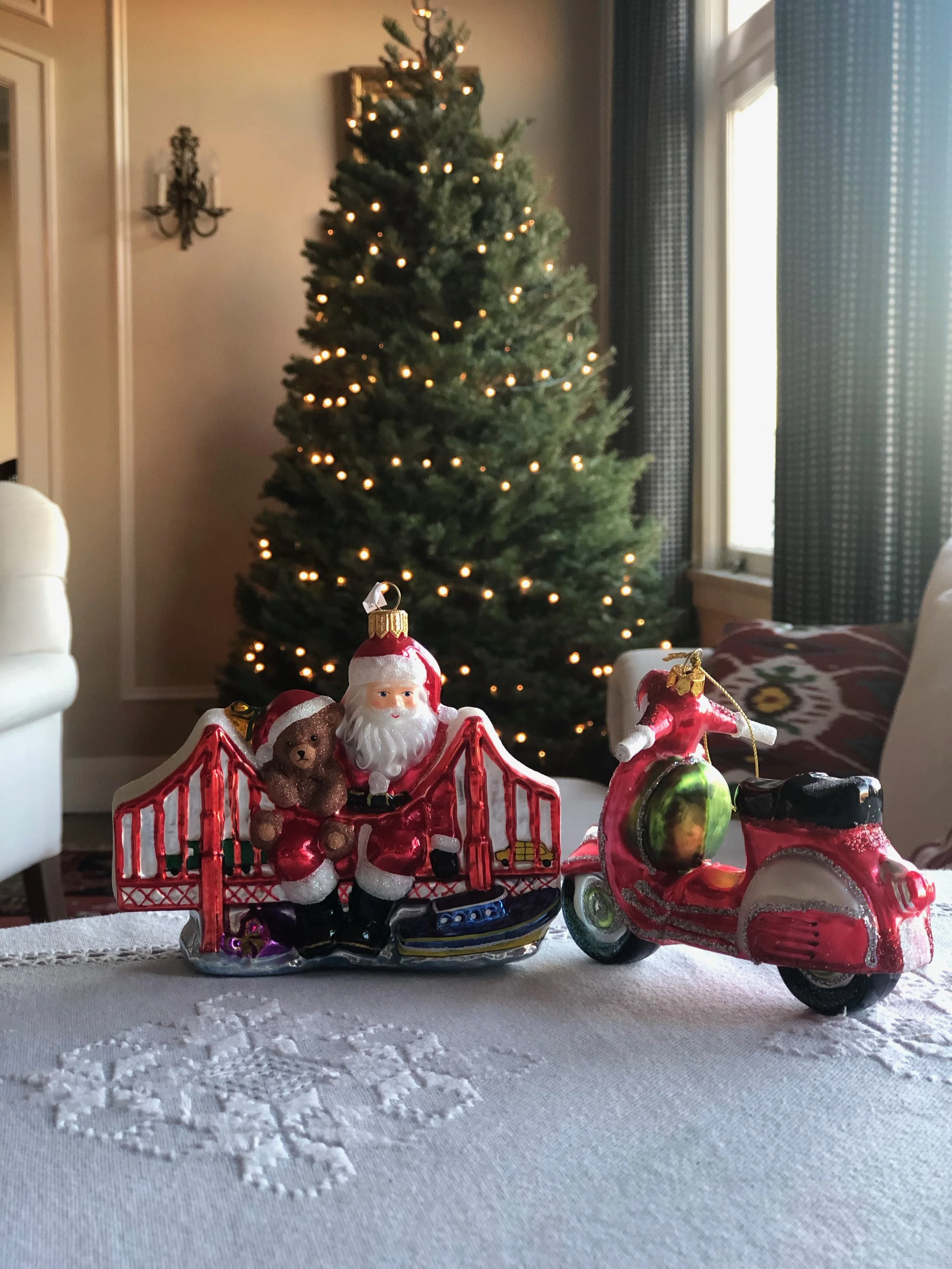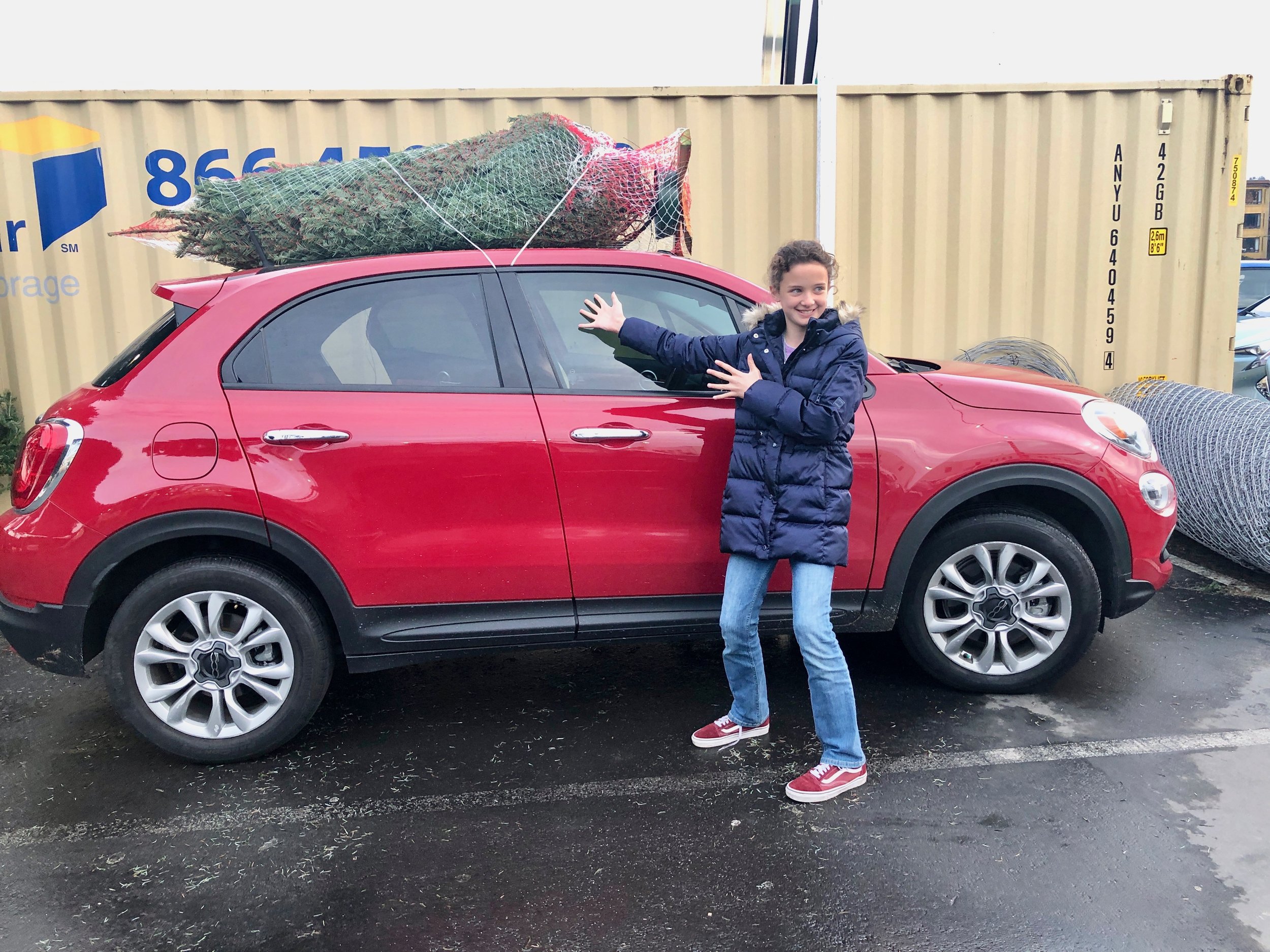OH, CHRISTMAS TREE!
I never realized how important a Christmas tree was to me until I considered not having one.
I first experienced this when we lived in Israel where it was easier to buy a menorah than a Balsam fir. We ended up buying a fake Christmas tree in Nazareth. We were reluctant to give into a plastic evergreen that opened up like a Technicolor umbrella. But, we figured that, if it came from the birthplace of Baby Jesus, then God would forgive us.
This year, we will be spending Christmas away from home, and leaving in mid-December. This has opened up a fiery debate in our family: do we pay for an over-priced real tree that will be appreciated for a short amount of time and likely dry up before Christmas Day? Or, do we buy another fake tree?
What about that fake tree from Nazareth? It has ended up adorning my husband’s office where it is already blinking in its full festive glory as protagonist to numerous holiday receptions.
“If Papi’s office gets a tree, then why can’t we have one?” asked my nine-year-old daughter.
We couldn’t avoid the topic because here, in San Francisco, the preparations for Christmas start promptly after Halloween, at the start of November. A few days after trick-or-treating, I watched my neighbors peel off cotton cobwebs from their shrubs and coat them with twinkly Christmas lights. Wreaths the size of hula-hoops magically appeared on their front doors replacing super-sized pumpkins, and garland was wrapped around outdoor banisters beckoning carolers.
Blow-up, life-sized Santas and Frosty The Snowmen fluttered off high-rise balconies. Advertisements for ice-skating rinks and Nutcracker performances were plastered across cable cars. Over the course of an autumnal week, Starbucks went from serving pumpkin lattes to Juniper lattes sprinkled with pine-citrus sugar. Storefronts replaced their turkey decals with polar bears, and ghosts with elves. Black Friday and Cyber Monday sales sent all shoppers into a tizzy without even leaving their living room. Elvis and Frank Sinatra crooned Christmas Carols on repeat at supermarkets, pharmacies and department stores. All this by December 1st.
Pumpkin patches which sold jack-o-lanterns at Halloween transformed into Christmas Tree lots faster than you could say mistletoe, offering evergreens from Napa and Sonoma as early as November 24th. Station wagons and SUVs whipped around town with pines or firs strapped perilously to their roof – trees before skis.
My husband and 12-year-old son voted against getting a real tree arguing that it cost too much for too little time to enjoy it. (A Christmas tree costs as much as pizza for four in San Francisco – and I found one lot that charged more for delivery than the tree itself.) Despite the outrageous cost which made me consider buying a tree in Utah instead, my daughter and I thought the boys were behaving like Grinches.
She and I stood strong in our desire for a tree -- fake or real, we’d take what we could get. Tradition was tradition, and we were going to be the tyrants of it. My desire for getting a tree in America comes from how easy it is to find one here – in living in other countries over the past 15 years, it hasn’t always been the case. Christmas elsewhere does not fall into your lap for a good portion of the fall season the way it does in America.
My daughter and I started off at Target, and found ourselves back there not once but twice in returning not one but two faulty, fake trees.
A sympathetic friend heard about our Target Tragedy and offered to lend us his fake tree. His house was under renovation so he didn’t have a living room this year in which he could display a tree. He and his partner promised to bring their tree to us over this past weekend on the roof of their SUV – they said our Fiat was too small to contain the three boxes in which it was stored. My daughter started jumping up and down at the anticipation of a tree about to enter our house.
The next day, a text with a photo appeared from our two friends: they were knee-deep in their storage bin, with frowns on their faces, their empty hands held high in the air.
“We feel like two Scrooges that stole Christmas,” they wrote. Their tree had gone missing – or at least half of it -- in their move before the house renovation. It was somewhere in storage, elsewhere, and there was no hope to recuperate it.
We all laughed. I fell asleep that night not with sugarplums in my head but plotting a heist of the Nazareth tree.
Over the years, I’ve concluded that diplomacy starts with Christmas. And I’m not talking only about the strategic mapping out of whose family we spend it with or which country or state we travel to – I’m talking about the traditions we all grew up with that we grasp onto for life.
For me, The Christmas Tree was everything. Because my father was born on December 25th, Christmas Day was always a double celebration. I grew up in the countryside where getting a tree from the woods or a nearby nursery was something as standard as putting gas in your car. Often it fell off the roof of the car as it was driven home and that was part of the adventure.
The Christmas Tree, for me, is the keystone to the heart of our home. It’s the family table around which we all gather, and celebrate the magic, mystery, and hope that the end of the year brings for the new year. I’ve also always loved how a tree brings nature into a home, and smells like the great outdoors.
It carries our family’s history in its ornaments: a popsicle stick frame created in kindergarten in Israel, a ceramic Vespa from Rome, a wooden waffle from Belgium, a plastic Santa Claus sitting on the Golden Gate Bridge. The angel that reigns on the top of our tree every year is a Labrador Retriever with wings, dressed in a white, flowy robe. We call him Ca’ Angelico. Each ornament is a reminder of where we’ve been, how far we’ve come, how much we’ve grown as a family.
Why buy a pumpkin and carve it? Why buy a bouquet of cut flowers? For the same reasons that we buy a tree and decorate it. Because it cheers up a living room or a front hall. It brings lightness to darkness. It symbolizes the passing on of tradition. And it often brings a smile to a face.
At my recent birthday dinner with my husband, I filled him in on The Christmas Tree conundrum. Maybe it was the margheritas we were drinking or maybe he felt sorry for me on my birthday, but, suddenly, he exclaimed, “Just get a real tree.”
My husband had graciously turned into Santa.
When my daughter heard the news and realized we wouldn’t have to return to Target for a third time, she hugged him with all her might and jumped up and down on our mattress.
A few days later, when she and I walked into the tree lot, I found one that I thought looked like a good compromise between a towering timber and a twig.
“We are not getting a tree that is shorter than I am,” she protested.
She chose one as tall as I am, and, within minutes, a burly, flanneled mountain man had strapped it to our car roof. We were due to pick up my son on the other side of town so we began our victory lap around San Francisco.
We drove over the Presidio and through the woods, and ended up in the Castro, where a rainbow-colored Christmas tree had been lit early that week. As we drove along in our small Fiat with the tree peering down on us through the sunroof, we passed school children who cheered “Merry Christmas!” and pointed at our tree.
At the very least, a Christmas tree brings joy to children – and often to adults, too. And my wanting to have a Christmas tree is also my desire to preserve the joy of childhood and unity of family as long as possible.





